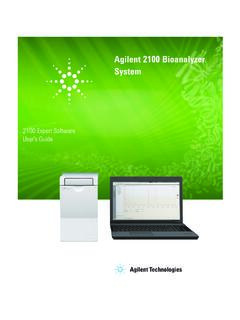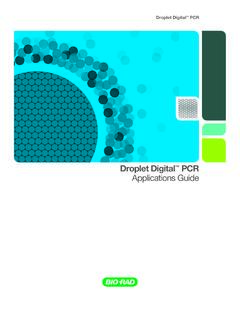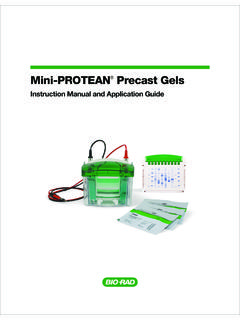Transcription of Good Laboratory Pipetting Guide - Pipette Calibration
1 Thermo ScientificFinnpipetteFinntipGood Laboratory Pipetting Guide2 ContentsIntroduction 3 Over 35 years of innovation 3 Pipettes and Pipetting 4 How pipettes work 4 Pipetting terminology 5 Recommendations for Pipetting different compounds 6 Getting started 6 Pipetting techniques 6 Pipetting in different applications 8 Selecting the tip 9 Ensuring optimum performance 9 Factors affecting the accuracy 10 Pipetting ergonomics 11 Decontamination Guidelines 12 Preventing cross-contamination 14 Maintenance and Service 14 Calibration of pipettes 15 Technical Information 18 Chemical resistance of plastics 18 Finntip compatibility table 19 Conversion table 20 ISO 8655 error limits 21 Warranty registration 23 troubleshooting 23 Good Laboratory Pipetting 35 Years of InnovationA leader in pipettingFor over 35 years, our goal has been to help customers in research and clinical laboratories to improve the speed, accuracy and precision of their Pipetting .
2 Since the introduction of the first continuously variable micropipette in 1971, more than three million Thermo Scientific Finnpipettes have been sold in 150 countries. During this time, we have listened to customer feedback to develop a wide variety of innovative models that are increasingly easy and comfortable to use. This Guide outlines Pipetting techniques and other practical information to help you achieve the best possible performance from your Finnpipette .Good Laboratory Pipetting GuideGood Laboratory Pipetting Guide4 Air displacement pipettingAir displacement Pipetting is highly accurate for standard Pipetting applications. However, conditions, such as atmospheric pressure as well as the specific gravity and viscosity of the solution, may effect the performance of air displacement tipHow an air displacement Pipette works?
3 1. The piston moves to the appropriate position when the volume is When the operating button is pressed to the first stop, the piston expels the same volume of air as indicated on the volume After immersing the tip into the liquid, the operating button is released. This creates a partial vacuum, and the specified volume of liquid is aspirated into the When the operating button is pressed to the first stop again, the air dispenses the liquid. To empty the tip completely, the operating button is pressed to the second stop (blow-out).How pipettes work?There are two types of pipettes: air displacement and positive displacement displacement pipettes are meant for general use with aqueous solutions. Positive displacement pipettes are used for highly viscous and volatile Pipette types have a piston that moves in a cylinder or capillary.
4 In air displacement pipettes, a certain volume of air remains between the piston and the liquid. In positive displacement Pipetting , the piston is in direct contact with the and PipettingAspirating the liquid (steps 1-3)Dispensing the liquid (step 4) displacement pipettingThe Thermo Scientific Finnpipette Stepper repeater Pipette uses the positive displacement principle. Disposable Stepper microsyringe tips have a piston inside a cylinder unit. This helps to avoid sample-to-sample cross-contamination (also known as sample carry-over) and contamination due to the aerosol the Thermo Scientific Finnpipette Stepper The piston inside the tip rises when filling the tip with When the dispensing lever is pressed down, the piston descends and the selected volume is dispensed. The dispensing lever has to be pressed once for each dispensing stroke (= step).
5 Finntip 50 ml1=1 mlPipetting terminologyThe following terms are used throughout this to draw the liquid up into the Pipette tipDispense to discharge the liquid from the tipBlow-out to discharge the residual liquid from the tipCalibration check to check the difference between the dispensed liquid and the selected volumeAdjustment altering the Pipette settings so that the dispensed volume is within the specifications Pipettes and PipettingSolution/compoundExamplesPipett eTipPipetting tech-niqueCommentsAqueous solutionBuffers, diluted salt solutionsAir displacementStandardForwardViscous solutionProtein and nucleic acid solutions, glycerol, Tween 20/40/60/80 Air displacementPositive displacementStandard or wide orfice Positive displacementReversePipette slowly to avoid bubble compoundsMethanol, hexaneAir displacementPositive displacementFilterPositive displacement ReversePipette rapidly to avoid evaporation.
6 Carbon filter tips prevent vapor going into the Pipette very effectivelyBody fluids Whole blood, serum Air displacementStandard or wide orifice tip Pipetting of hetero-geneous samples Residual liquid can be found on the outer surface of the tip. Wipe the tip against the edge of the vessel to remove this liquid before solutionsGonomic DNA, PCR productsAir displacementPositive displacementFilter or wide orifice Positive displacementForwardFor genomic DNA wide orifice tips can be used to eliminate mechanical compounds14 Carbonate, 3H-thy-midineAir displacementPositive displacementFilterPositive displacementForwardAcids/alkalisH2SO4, HCI, NaOHAir displacementFilterForwardToxic samplesAir displacementPositive displacementFilterPositive displacementForward or reverseRecommendations for Pipetting different compounds6 Check your Pipette at the beginning of your working day for dust and dirt on the outside.
7 If needed, wipe with 70% ethanol. Check that you are using tips recommended by the manufacturer. To ensure accuracy, use only high-quality tips made from contamination-free polypropylene. Tips are designed for single use. They should not be cleaned for reuse, as their metrological characteristics will no longer be reliable. Pre-rinsing (three to five times) the tip with the liquid to be pipetted improves accuracy. This is especially important when Pipetting volatile compounds since it prevents liquid from dripping out of the tip. Pipette parallel samples in a similar way. Avoid turning the Pipette on its side when there is liquid in the tip. Liquid might get into the interior of the Pipette and contaminate the Pipette . Avoid contamination to or from hands by using the tip ejector. Always store pipettes in an upright position when not in use.
8 Finnpipette stands are ideal for this startedYes: When Pipetting and mixing a sample or reagent into another forward technique is recommended for aqueous solutions, such as buffers, diluted acids or alkalis. Ready position 1 2 3 4 First stopSecond stopForward pipettingOtherwise no: Formation of bubbles or foam in the tip or in the test tube or Press the operating button to the first Dip the tip into the solution to a depth of 1 cm, and slowly release the operating button. Withdraw the tip from the liquid, touching it against the edge of the reservoir to remove excess liquid. 3. Dispense the liquid into the receiving vessel by gently pressing the operating button to the first stop. After one second, press the operating button to the second stop. This action will empty the tip. Remove the tip from the vessel, sliding it along the wall of the Release the operating button to the ready and PipettingPipetting : For Pipetting samples or reagents when no mixing into another liquid is Pipetting avoids the risk of splashing, and foam or bubble reverse technique is used for Pipetting solutions with a high Ready position 1 2 3 4 5 First stopSecond stopReverse pipettingviscosity or a tendency to foam.
9 This method is also recommended for dispensing small volumes. It can also be used with air displacement Press the operating button to the second Dip the tip into the solution to a depth of 1 cm, and slowly release the operating button. This action will fill the tip. Withdraw the tip from the liquid, touching it against the edge of the reservoir to remove excess liquid. 3. Dispense the liquid into the receiving vessel by depressing the operating button gently and steadily to the first stop. Hold the button in this position. Some liquid will remain in the tip, and this should not be The liquid remaining in the tip can be pipetted back into the original solution or thrown away with the Release the operating button to the ready : Especially for adding reagents into tubes or into the wells of technique is intended for repeated Pipetting of the same Pipetting Ready position 1 2 3 4 First stopSecond stop1.
10 Press the operating button to the second Dip the tip into the solution to a depth of 1 cm, and slowly release the operating button. Withdraw the tip from the liquid, touching it against the edge of the reservoir to remove excess liquid. 3. Dispense the liquid into the receiving vessel by gently pressing the operating button to the first stop. Hold the button in this position. Some liquid will remain in the tip, and this should not be dis- pensed. 4. Continue Pipetting by repeating steps 2 and position 1 2 3 4 5 6 First stopSecond stopYes: When prerinsing the tip is not possible and the full sample should be dispensed for correct technique is used for Pipetting heterogeneous samples, such as blood or of heterogeneous samples1. Press the operating button to the first stop. Dip the tip into the sample.




